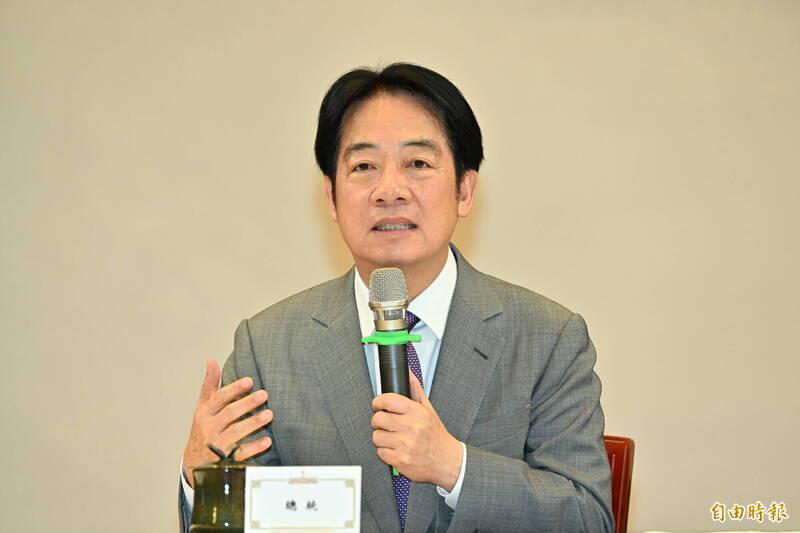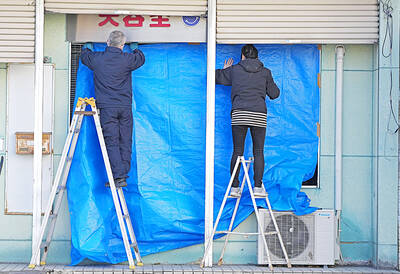President William Lai (賴清德) called the 20-percent tariff announced just hours earlier by Washington on most Taiwanese imports “progress in a phased manner” in a news conference in Taipei this morning.
However, the 20-percent tariff was not a target pursued by Taiwan from the beginning, he said, expressing hope that Taiwan could get a better tariff rate in the ongoing negotiation with the US.
The rate has not been finalized, he said, adding that the US has also expressed its willingness to continue negotiating.

Photo: Tien Yu-hua, Taipei Times
Taiwan has conducted rounds of negotiations since the US imposed tariffs on various countries in April, aiming to address trade imbalance and uphold the principle of reciprocity, Lai said.
The US imposed sweeping import taxes on more than 100 countries and regions in early April, including a blanket 32-percent tariff on most Taiwanese goods, excluding semiconductors, which would be addressed through separate negotiations.
Countries engaging in tariff talks with the US have signed a confidentiality agreement, which is why the government is not allowed to publicize negotiation details, including the tariff rate and the potential investment amount, before the negotiation is concluded, Lai said when responding to the opposition’s accusation of “keeping the public in the dark.”
The government would publicize news concerning the joint statement once the result is finalized, he said.
Taiwan has made it clear to the US that the government is accountable to the legislature and society as it is a democratic country, Lai said, stressing that anything concerning the legislature must be approved by it and obtain support from the public.
He said he hopes the opposition would support Taiwan’s delegation as they are fighting for national interests, safeguarding local industries, promoting public health and ensuring food security.
Through the ongoing negotiation, Taiwan is to deepen economic cooperation with the US, especially in terms of national defense, technology and other areas, to boost Taiwan’s competitiveness, he said.
Lai also said he hopes the Executive Yuan could send the special act budget, which includes NT$93 billion for economic resilience, to the legislature as soon as possible, citing the potential impact of the US tariffs on various industries.
Premier Cho Jung-tai (卓榮泰) said the government has been supporting local businesses in the past few months, but it is to reevaluate the situation in accordance with the newly announced tariff rate.
A US official said Lai's statement that negotiations were continuing was "accurate."
"The interim rate is lower than the original rate, and it's much lower than that of several other major trading partners with ongoing negotiations. We can interpret this as Taiwan's offer being well received and being close to a final agreement," said the official who declined to be identified given the sensitivity of the issue.
A US-Taiwan economic and trade task force under the Executive Yuan said today that the 20-percent tariff is “tentative” and that negotiations between the two sides would continue.
The task force said the “tentative” tariff was announced because the US and Taiwan had not concluded talks by the Aug. 1 deadline, due to a schedule set by Washington, which had to negotiate with multiple countries.
Both sides still need further talks to reach a final agreement, and Taiwan would seek to meet with US representatives as soon as possible to negotiate a lower tariff, the task force said.
Both Lai and the task force said Taipei and Washington are expected to begin talks on semiconductors, the backbone of Taiwan’s exports, which have been threatened by Trump.
Taiwan Semiconductor Manufacturing Co. (TSMC), which is investing US$65 billion in Arizona and has pledged an additional US$100 billion, has warned Washington that future tariffs on Taiwanese semiconductors could reduce demand for chips and jeopardize its investment plans in the state.
An official explained that the new tariff rate would take effect at 12:01am seven days after the signing of the executive order, excluding the day of signing.
This means Taiwan still has a week to reach an agreement with the US, and there remains a chance that the final tariff rate could be reduced, the official said.
The US did not mention opening Taiwan markets or investment in its statement, which shows the negotiations are still ongoing, a source said.
The source stressed that this is a provisional tariff rate that is subject to change once the US and Taiwan reach a final trade agreement.
Japan and Korea paid a high price for their 15-percent tariff rate, and although Taiwan’s 20 percent tariff is not ideal, it is “not the worst” possible outcome, said Darson Chiu (邱達生), an economics professor at Tunghai University in Taichung and director-general of the Confederation of Asia-Pacific Chambers of Commerce and Industry.
Trump originally said Taiwan would be given “the best tariff rate,” and Taiwan’s goal was to get a rate no higher than Japan or Korea, said Chiu.
As the rate announced today was 20 percent, higher than Japan and Korea’s 15 percent, it is reasonable to infer that the government made a trade-off after considering the conditions attached to a 15-percent tariff, he said.
Additional reporting by Reuters, Kao Chia-ho and Chung Li-hua

Taiwanese were praised for their composure after a video filmed by Taiwanese tourists capturing the moment a magnitude 7.5 earthquake struck Japan’s Aomori Prefecture went viral on social media. The video shows a hotel room shaking violently amid Monday’s quake, with objects falling to the ground. Two Taiwanese began filming with their mobile phones, while two others held the sides of a TV to prevent it from falling. When the shaking stopped, the pair calmly took down the TV and laid it flat on a tatami mat, the video shows. The video also captured the group talking about the safety of their companions bathing

US climber Alex Honnold is to attempt to scale Taipei 101 without a rope and harness in a live Netflix special on Jan. 24, the streaming platform announced on Wednesday. Accounting for the time difference, the two-hour broadcast of Honnold’s climb, called Skyscraper Live, is to air on Jan. 23 in the US, Netflix said in a statement. Honnold, 40, was the first person ever to free solo climb the 900m El Capitan rock formation in Yosemite National Park — a feat that was recorded and later made into the 2018 documentary film Free Solo. Netflix previewed Skyscraper Live in October, after videos

Starting on Jan. 1, YouBike riders must have insurance to use the service, and a six-month trial of NT$5 coupons under certain conditions would be implemented to balance bike shortages, a joint statement from transportation departments across Taipei, New Taipei City and Taoyuan announced yesterday. The rental bike system operator said that coupons would be offered to riders to rent bikes from full stations, for riders who take out an electric-assisted bike from a full station, and for riders who return a bike to an empty station. All riders with YouBike accounts are automatically eligible for the program, and each membership account

A classified Pentagon-produced, multiyear assessment — the Overmatch brief — highlighted unreported Chinese capabilities to destroy US military assets and identified US supply chain choke points, painting a disturbing picture of waning US military might, a New York Times editorial published on Monday said. US Secretary of Defense Pete Hegseth’s comments in November last year that “we lose every time” in Pentagon-conducted war games pitting the US against China further highlighted the uncertainty about the US’ capability to intervene in the event of a Chinese invasion of Taiwan. “It shows the Pentagon’s overreliance on expensive, vulnerable weapons as adversaries field cheap, technologically